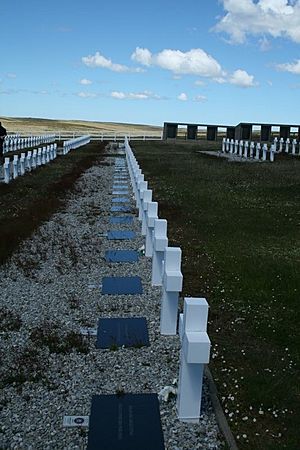Argentine Military Cemetery facts for kids
Quick facts for kids The Argentine Military Cemetery on East Falkland |
|
|---|---|
| Falkland Islands (Spanish: Islas Malvinas) | |

|
|
| For Argentine forces | |
| Established | 1983 |
| Location | 51°47′49″S 58°56′26″W / 51.79694°S 58.94056°W East Falkland
near |
| Total burials | 236 |
|
Unknowns
|
10 |
| Commemorated | 649 |
| Burials by nation | |
|
* Argentina – 236
|
|
| Burials by war | |
|
* Falklands War – 236
|
|
The Argentine Military Cemetery, also known as Cementerio de Darwin, is a special burial ground on East Falkland. It holds the bodies of 236 Argentine soldiers. These soldiers died during the 1982 Falklands War (called Guerra de las Malvinas in Spanish). The cemetery is near the Darwin Settlement, where a big battle took place. There's even a copy of this cemetery in Berazategui, Argentina.
History of the Cemetery
When the war ended on June 14, 1982, many Argentine soldiers were buried in temporary graves. These graves were often close to where the soldiers had fallen. Britain offered to send the bodies back to Argentina. However, the Argentine government at the time said the soldiers were already in their homeland.
In December 1982, the British government hired a team of civilian undertakers. This team was led by British Army Colonel Geoffrey Cardozo. Their job was to gather all the temporary graves on the islands. They brought all the bodies to one place: Port Darwin. This area was already the largest burial site for Argentine soldiers. It held the bodies of 47 soldiers who died in the Battle of Goose Green.
Many bodies did not have dog tags (ID tags). The team tried their best to identify each soldier. They looked for personal items found on the bodies. Each soldier was given a Christian burial with full military honors. Each grave has a white wooden cross. If the soldier's name was known, it was written on the cross. If not, the cross reads Soldado Argentino Solo Conocido Por Dios. This means "Argentine Soldier Known Only By God".
The cemetery is surrounded by a wall. It has a special monument called a cenotaph. This monument includes a picture of Argentina's patron saint, the Virgen del Lujan. Around the graves, glass plaques list the names of all 649 Argentine soldiers, sailors, and airmen. These brave people lost their lives in the war. Their families asked that no military rank or service be shown.
Since the war, the bodies of three more Argentine pilots have been buried here:
- Captain Jorge Osvaldo García was a pilot whose plane was shot down. He was found in a dinghy in 1983.
- Lieutenant Miguel Giménez was a pilot whose body was found in 1986. His family was the first Argentine family to visit the Falklands since the war.
- Lieutenant Jorge Casco was another pilot. He crashed in bad weather and was buried on March 7, 2009. His family wanted him buried in the Falklands, even after his identity was confirmed by DNA testing in Argentina.
On November 9, 2002, Prince Andrew visited the cemetery. He was a veteran of the Falklands War himself. He laid a wreath and spoke about losing friends in the war. He said he understood what the Argentine families felt.
Since 1999, Argentine families have been in charge of the cemetery's care. In 2007, Sebastián Socodo, an Argentine man married to a Falkland Islander, was hired to maintain the cemetery.
Where is the Cemetery?
In Argentina, the cemetery is often called Cementerio de Darwin. However, it is actually several miles away from the main Darwin settlement. The area where the cemetery is located was known as Teal Creek. There are no Argentine soldiers buried in the Darwin cemetery that is inside the settlement itself.
Identifying Soldiers with DNA
A special project helped identify the unknown soldiers. The UK, Falkland Islands, Argentine Government, and the International Committee of the Red Cross (ICRC) worked together. A team of experts used DNA to identify the remains in the unknown graves. They compared the DNA to samples from the soldiers' families. Both the UK and Argentine governments helped pay for this project. It was a humanitarian effort to help families find their loved ones.
In September 2016, the UK and Argentina agreed to fully support this DNA identification process. The ICRC's team began their work in June 2017. Scientists in Argentina, the United Kingdom, and Spain confirmed the DNA results.
By March 2018, 90 bodies had been identified. More than 200 relatives were able to visit the graves for the first time. On March 26, 2018, Argentine officials and Colonel Geoffrey Cardozo joined the families. A religious ceremony was held by bishops from Argentina and the United Kingdom. Since then, more DNA samples have helped identify 115 bodies. There are still 10 bodies left to identify, and plans are in place to continue this work.
Some soldiers' remains have been returned to Argentina. For example, Lieutenant Luis Castagnari was buried in the Darwin cemetery after the war. In December 2018, his wife asked for his remains to be returned to Argentina. He was cremated and reburied in Río Cuarto, Córdoba.
See Also
- Blue Beach Military Cemetery at San Carlos – which holds the remains of 14 unrepatriated British servicemen
- Falkland Islands sovereignty dispute#Post-war
- Grytviken Cemetery – which holds the remains of Félix Artuso, an Argentinian submarine officer who was killed in the 1982 British recapture of South Georgia from Argentina


